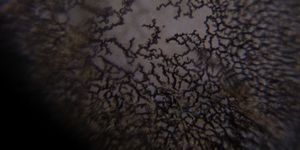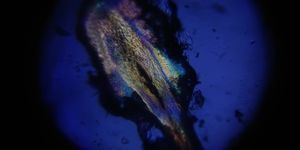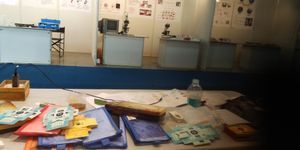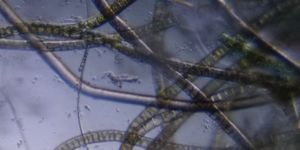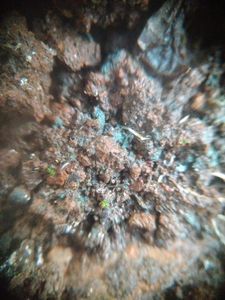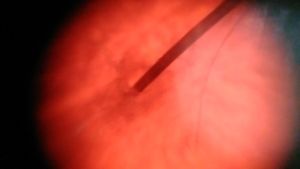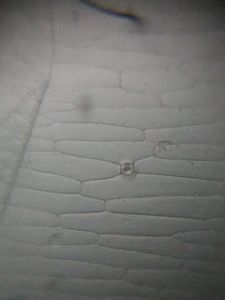Insight into Parasites – A ‘101’ on Viruses
 Jun 12, 2020 • 4:36 AM UTC
Jun 12, 2020 • 4:36 AM UTC Unknown Location
Unknown Location 140x Magnification
140x Magnification Insects and Arachnids
Insects and Arachnids
Ronak Hati
Learn about the author...
31posts
53comments
2locations
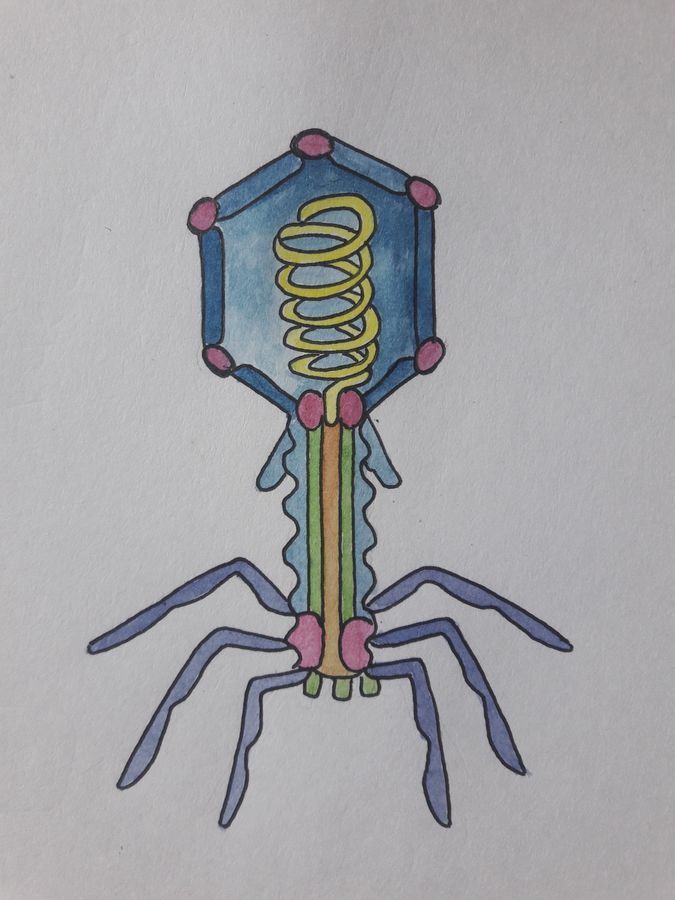
(A small write-up, written by my batchmates and I. Decided to post this here. Hope you enjoy reading it :D)
_____
While we’ve been locked in our houses due to the COVID-19 pandemic and are wondering when life will be back to normal, we are reminded again and again that a tiny virus has brought our world to a stop. A minuscule entity, only visible under the strongest microscopes, that cannot even be considered a living thing has wreaked havoc across the globe! Yes, that’s right a virus is neither dead nor alive!
The general understanding is that there is no cure or vaccine against COVID-19 presently. People have been resorting to extraordinary measures like injecting disinfectant in their body or ‘eating dandelions of pH 22 because Coronavirus can’t survive at a high pH’. Such claims have been rampant in WhatsApp forwards and have resulted in numerous misconceptions about viruses. Let’s fight misinformation with information. Let’s start by knowing about viruses.
_____
While we’ve been locked in our houses due to the COVID-19 pandemic and are wondering when life will be back to normal, we are reminded again and again that a tiny virus has brought our world to a stop. A minuscule entity, only visible under the strongest microscopes, that cannot even be considered a living thing has wreaked havoc across the globe! Yes, that’s right a virus is neither dead nor alive!
The general understanding is that there is no cure or vaccine against COVID-19 presently. People have been resorting to extraordinary measures like injecting disinfectant in their body or ‘eating dandelions of pH 22 because Coronavirus can’t survive at a high pH’. Such claims have been rampant in WhatsApp forwards and have resulted in numerous misconceptions about viruses. Let’s fight misinformation with information. Let’s start by knowing about viruses.
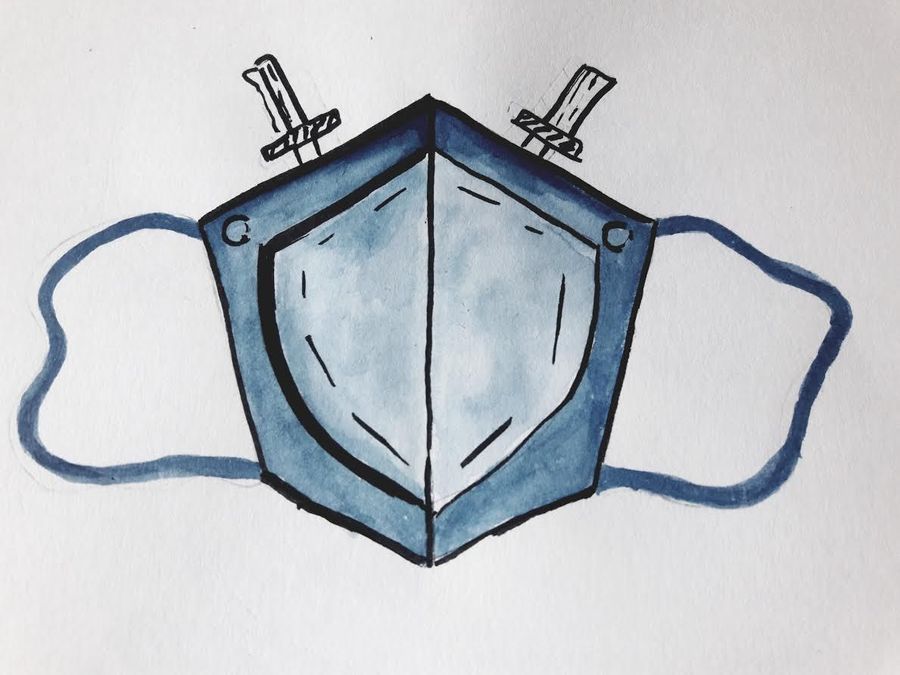
“When pandemics become a war, masks play the role of shields.” _____
What are viruses? The best way to describe viruses would be as ‘acellular, submicroscopic infectious agents that cannot reproduce on their own’. They are so tiny that we require special microscopes to view them – just like how we build special telescopes to look at distant galaxies and black holes. They have once been the ‘black holes’ of biology, being rendered white with time. They are a popular topic of research.
To understand what ‘acellular’ is, we must take a look at what ‘cellular’ means. All life forms including plants, fungi, animals including us, and even bacteria are made up of cells – an independent, membrane-enclosed compartment with machinery to produce proteins (called ribosomes), an instruction manual for their production (genetic material aka DNA), and other lipid and sugar molecules. These molecules constantly react with each other; so a membrane encloses within itself tons of chemical reactions necessary to sustain life in the cell.
But take a virus, and you will see that these chemical reactions are absent. A virus may or may not have a membrane made up of lipids, but has a coat of proteins that surrounds either a DNA or RNA genome – the set of codes necessary to create them. Provide a cell with all essential nutrients, and you will see that it grows, makes copies of itself, increases its number, and at some point dies. Do the same with an intact virus and you will see no change – it remains as it is – inanimate. This particular aspect makes it difficult to even call viruses a lifeform or even put them along with other cellular life forms. Of course, some cellular life forms will not grow if you performed the same experiment on them. These are intracellular parasites, they need to exist inside other cells to live. But what makes viruses different from them, we will discuss shortly.
A cell while growing not only grows in size and divides – it creates exactly two copies of its DNA which each daughter cell takes away. A virus cannot do this by themselves. Similarly, a cell makes a copy of its DNA into RNA (aka ‘transcription’) and then ‘translates’ the RNA into strands of protein using the ribosome factories. A virus lacks ribosomes – it cannot make proteins on its own. Instead like a parasite, it makes copies of itself by cleverly hijacking a cell and making use of the cell’s machinery. Imagine it as a scenario where a gunman has entered your house, hands out a recipe to you, and makes you cook food for themself at gunpoint. Ultimately it kills off the cell.
To make a cell its slave and use its machinery, viruses have to enter inside it – more specifically their genetic material has to. How do they achieve this? Specific proteins lying on the surface of viruses bind perfectly to specific molecules on the surface of the cell. To say, viruses have keys to locks on cells. Keys that fit perfectly into the lock! That’s how they open the door and enter inside easily. Once inside, they do what they need to. After making several copies of themselves, viruses exit the cell. Outside, they are nothing but lifeless. That’s why antibiotics – even the most potent ones that wreak havoc on bacteria – don’t work on them; these drugs are meant to act on living processes. Often, drugs that do affect them affect some aspects of the victim cells as well, since viruses thrive on the chemical reactions within a cell and we need to target these reactions to get them.
The recipe for concocting viruses gets handed down every generation. But the one forwarded is not the original recipe. Say, if the recipe was for making a cake, the original recipe would say “Add one spoonful of sugar” while the new one would say “Add three spoons of sugar”. Mistakes are made when the recipe is copied down for the next generation. Through generations, a unique recipe gets created, and with it a new strain of the virus. If the original one could infect another animal (say our friends in the wild), the new one might infect humans too. That’s how epidemics erupt. We, humans, have no idea when new viruses would evolve into existence – our bodies are highly unprepared for them. That is what happened with COVID-19. The virus caught us off guard.
Our body tries to fight off viruses regardless. Let us see how.
_____
Viruses and our immune system Our own body has an immune system: a vast array of soldiers ready to wage war on an intruder virus. One of the best ways to kill off viruses is to do away with the cell that has become their victim; preventing them from creating further copies – a task performed by specialized immune cells.
A lifeless virus floating in space is much easier to deal with than those inside. A set of our proteins floating around in our body called antibodies act as locks that never open – they fit perfectly on the keys that viruses have and make those defective, so they can no longer infect another cell. Subsequently, the viruses are cleared away.
What are viruses? The best way to describe viruses would be as ‘acellular, submicroscopic infectious agents that cannot reproduce on their own’. They are so tiny that we require special microscopes to view them – just like how we build special telescopes to look at distant galaxies and black holes. They have once been the ‘black holes’ of biology, being rendered white with time. They are a popular topic of research.
To understand what ‘acellular’ is, we must take a look at what ‘cellular’ means. All life forms including plants, fungi, animals including us, and even bacteria are made up of cells – an independent, membrane-enclosed compartment with machinery to produce proteins (called ribosomes), an instruction manual for their production (genetic material aka DNA), and other lipid and sugar molecules. These molecules constantly react with each other; so a membrane encloses within itself tons of chemical reactions necessary to sustain life in the cell.
But take a virus, and you will see that these chemical reactions are absent. A virus may or may not have a membrane made up of lipids, but has a coat of proteins that surrounds either a DNA or RNA genome – the set of codes necessary to create them. Provide a cell with all essential nutrients, and you will see that it grows, makes copies of itself, increases its number, and at some point dies. Do the same with an intact virus and you will see no change – it remains as it is – inanimate. This particular aspect makes it difficult to even call viruses a lifeform or even put them along with other cellular life forms. Of course, some cellular life forms will not grow if you performed the same experiment on them. These are intracellular parasites, they need to exist inside other cells to live. But what makes viruses different from them, we will discuss shortly.
A cell while growing not only grows in size and divides – it creates exactly two copies of its DNA which each daughter cell takes away. A virus cannot do this by themselves. Similarly, a cell makes a copy of its DNA into RNA (aka ‘transcription’) and then ‘translates’ the RNA into strands of protein using the ribosome factories. A virus lacks ribosomes – it cannot make proteins on its own. Instead like a parasite, it makes copies of itself by cleverly hijacking a cell and making use of the cell’s machinery. Imagine it as a scenario where a gunman has entered your house, hands out a recipe to you, and makes you cook food for themself at gunpoint. Ultimately it kills off the cell.
To make a cell its slave and use its machinery, viruses have to enter inside it – more specifically their genetic material has to. How do they achieve this? Specific proteins lying on the surface of viruses bind perfectly to specific molecules on the surface of the cell. To say, viruses have keys to locks on cells. Keys that fit perfectly into the lock! That’s how they open the door and enter inside easily. Once inside, they do what they need to. After making several copies of themselves, viruses exit the cell. Outside, they are nothing but lifeless. That’s why antibiotics – even the most potent ones that wreak havoc on bacteria – don’t work on them; these drugs are meant to act on living processes. Often, drugs that do affect them affect some aspects of the victim cells as well, since viruses thrive on the chemical reactions within a cell and we need to target these reactions to get them.
The recipe for concocting viruses gets handed down every generation. But the one forwarded is not the original recipe. Say, if the recipe was for making a cake, the original recipe would say “Add one spoonful of sugar” while the new one would say “Add three spoons of sugar”. Mistakes are made when the recipe is copied down for the next generation. Through generations, a unique recipe gets created, and with it a new strain of the virus. If the original one could infect another animal (say our friends in the wild), the new one might infect humans too. That’s how epidemics erupt. We, humans, have no idea when new viruses would evolve into existence – our bodies are highly unprepared for them. That is what happened with COVID-19. The virus caught us off guard.
Our body tries to fight off viruses regardless. Let us see how.
_____
Viruses and our immune system Our own body has an immune system: a vast array of soldiers ready to wage war on an intruder virus. One of the best ways to kill off viruses is to do away with the cell that has become their victim; preventing them from creating further copies – a task performed by specialized immune cells.
A lifeless virus floating in space is much easier to deal with than those inside. A set of our proteins floating around in our body called antibodies act as locks that never open – they fit perfectly on the keys that viruses have and make those defective, so they can no longer infect another cell. Subsequently, the viruses are cleared away.
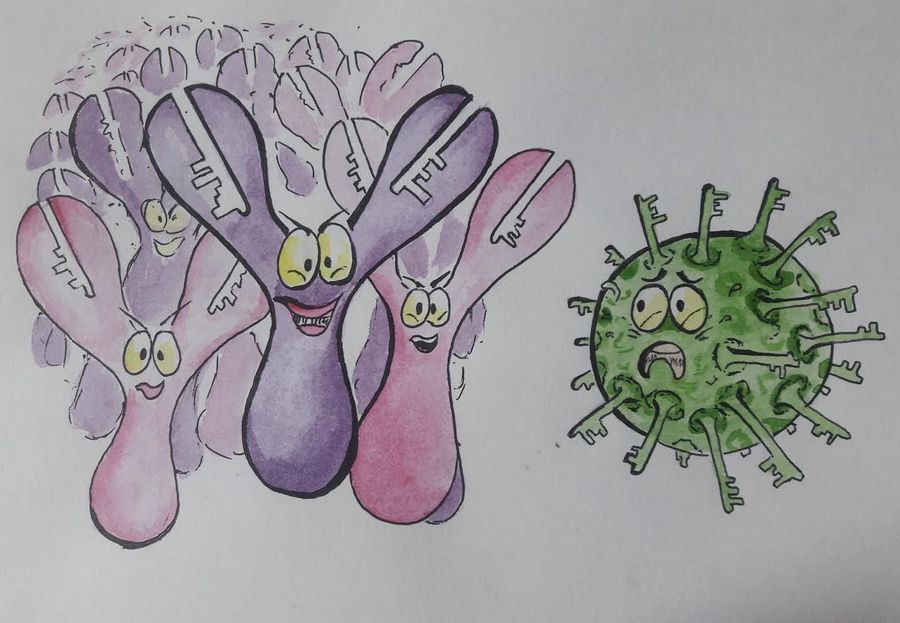
“When a virus meets antibodies” Even though our system tries hard to keep this war peaceful, sometimes even more chaos ensues than what viruses would alone cause. After all, a battlefield is bound to get chaotic. Some amount of chaos is tolerated. Symptoms like cold, cough, fatigue, inflammation arise due to this chaos. Inflammation is one of the classical responses of the immune system meant to eliminate the intruder, with five cardinal signs: rubor (redness), calor (increased heat), tumor (swelling), dolor (pain) and functio laesa (disturbance of function) of the affected area of the body – things that can get out of hand as well.
Our nemesis, COVID-19, better exemplifies this. SARS-CoV-2, the virus that causes COVID-19, can infect cells of the alveoli – regions in our lungs where carbon dioxide is exchanged with oxygen from the air. A slight amount of inflammation is necessary for the lungs as they come in contact with outsiders daily. But with COVID-19, it presents a problem. It swells up the lungs and fills the alveoli with a large amount of fluid. This hinders their ability to carry out the exchange of gases and causes the body to become deficient in oxygen – leading to something called Acute Respiratory Distress Syndrome (ARDS). As we do not have a cure yet, managing this disease currently involves providing supportive care; the patient’s lungs need to be ventilated when ARDS occurs.
The immune system often becomes aggressive when it encounters something offending. Soldiers jump into action randomly. This happens when the intruder is unknown. But we have found a way to safely train our soldiers using vaccines – so they recognize the intruder beforehand. Vaccines are either a less harmful version of a pathogen or a version that’s not harmful at all (i.e. bits and pieces of the pathogen). Vaccination is similar to carrying out a practice drill with the immune system so that it reacts faster when it next encounters an actual intruder. That way, it eliminates the intruder even before it causes any damage!
Our nemesis, COVID-19, better exemplifies this. SARS-CoV-2, the virus that causes COVID-19, can infect cells of the alveoli – regions in our lungs where carbon dioxide is exchanged with oxygen from the air. A slight amount of inflammation is necessary for the lungs as they come in contact with outsiders daily. But with COVID-19, it presents a problem. It swells up the lungs and fills the alveoli with a large amount of fluid. This hinders their ability to carry out the exchange of gases and causes the body to become deficient in oxygen – leading to something called Acute Respiratory Distress Syndrome (ARDS). As we do not have a cure yet, managing this disease currently involves providing supportive care; the patient’s lungs need to be ventilated when ARDS occurs.
The immune system often becomes aggressive when it encounters something offending. Soldiers jump into action randomly. This happens when the intruder is unknown. But we have found a way to safely train our soldiers using vaccines – so they recognize the intruder beforehand. Vaccines are either a less harmful version of a pathogen or a version that’s not harmful at all (i.e. bits and pieces of the pathogen). Vaccination is similar to carrying out a practice drill with the immune system so that it reacts faster when it next encounters an actual intruder. That way, it eliminates the intruder even before it causes any damage!
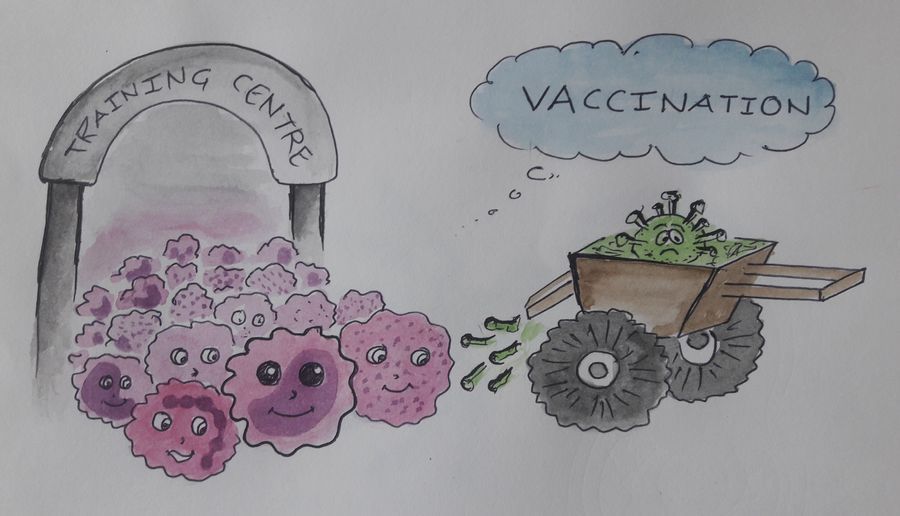
“Imagine what happens in the barracks of our immune system…” Efforts at developing vaccines against COVID-19 are under progress in many countries. It seems pretty straightforward to develop a vaccine as we have the data profile of the virus, but introducing them into the market, or any drug for that matter has always been a lengthy process. A long time goes into ascertaining whether a vaccine is suitable for human use without any adverse side effects. It wouldn’t be surprising if it took months and months to develop one of them successfully. So what should we do till then? The answer has already been given to us by authorities everywhere: SOCIAL DISTANCING.
Viruses do not cause disease with intent. They reproduce to avoid getting eradicated – something every creature on this planet does. We are their host. They do not reproduce indefinitely in one host; they need others too. They get transmitted from one person to another. So we must break this ‘chain’ of transmission by denying them what they want. Social distancing is one of the only ways we have now against SARS-CoV-2. While we term it ‘social’ it involves ‘physical’ distancing. We cannot know if someone has COVID-19 just by looking at them; so in this context, we must avoid close contact with each other.
While we speak ill of viruses, there is another side of the coin.
_____
Not all are bad! While they indeed make most living beings sick, viruses are beneficial too. They are a helpful force when it comes to maintaining the ecological balance. They, among other things, ensure that living beings do not increase in numbers beyond which nature can handle. After all, resources are limited and consumers many.
Most of the biomass in oceans is contained in bacteria and other microbes. For recycling this matter into other lifeforms, this biomass needs to be released. Bacteriophages (viruses that infect bacteria) are instrumental in this. They reproduce in and kill about 20% of these bacteria daily. The progeny phages, in turn, end up as food for other life forms, since they are nothing but proteins and nucleic acids and cannot infect someone other than their host. This also maintains their population at an optimum. That’s one of the ways biomass is continuously recycled.
Viruses do not cause disease with intent. They reproduce to avoid getting eradicated – something every creature on this planet does. We are their host. They do not reproduce indefinitely in one host; they need others too. They get transmitted from one person to another. So we must break this ‘chain’ of transmission by denying them what they want. Social distancing is one of the only ways we have now against SARS-CoV-2. While we term it ‘social’ it involves ‘physical’ distancing. We cannot know if someone has COVID-19 just by looking at them; so in this context, we must avoid close contact with each other.
While we speak ill of viruses, there is another side of the coin.
_____
Not all are bad! While they indeed make most living beings sick, viruses are beneficial too. They are a helpful force when it comes to maintaining the ecological balance. They, among other things, ensure that living beings do not increase in numbers beyond which nature can handle. After all, resources are limited and consumers many.
Most of the biomass in oceans is contained in bacteria and other microbes. For recycling this matter into other lifeforms, this biomass needs to be released. Bacteriophages (viruses that infect bacteria) are instrumental in this. They reproduce in and kill about 20% of these bacteria daily. The progeny phages, in turn, end up as food for other life forms, since they are nothing but proteins and nucleic acids and cannot infect someone other than their host. This also maintains their population at an optimum. That’s one of the ways biomass is continuously recycled.

“Bacteriophages – the spidermen of the virus world. Only some look like this, though.” Our intestines are lined with trillions of bacteria, many of whom are beneficial to us. But beyond a limit, even they could become harmful. Our body alone would fail to maintain at optimum the number of bacteria from each species. Who better could do this job more specifically than bacteriophages? This specificity gave rise to the field of ‘phage therapy’ – the use of viruses in place of antibiotics to treat diseases caused by bacteria. While antibiotics do not increase in concentration as time passes, phages would do so as they kill more and more pathogenic bacteria. Also with the rise of drug-resistant bacteria, they may just end up becoming the new medicine!
While a variety of bacteria have made us their home, a large number of viruses exist within us too. Some infect us, while some infect the bacteria within us. Interestingly, they form some parts of our DNA too! Once upon a time, they were viable viruses that could infect our ancestors. They needed to integrate their DNA with the DNA of our ancestors while reproducing themselves. Through some crazy turn of events, they ended up infecting sperms and eggs. Thus, their DNA was carried down through generations. With time, the viral DNA lost the ability to create a virus, remaining as relics of the past. We all are ‘part viral’…
_____
We do not know for sure how viruses have originated. We might understand more about our origin if we understood theirs, as they are creatures on the edge of life. Regardless of how mysterious they are, they have both good and bad aspects to them. We must cherish the uniqueness of these entities.
We hope you have learned a thing or two about viruses from this write-up. Do not fall prey to misinformation. Stay safe and take care 🙂
_____
Written by
Shabduli Shinde
Ronak Hati
Illustrations by
Sakshee Dubal
While a variety of bacteria have made us their home, a large number of viruses exist within us too. Some infect us, while some infect the bacteria within us. Interestingly, they form some parts of our DNA too! Once upon a time, they were viable viruses that could infect our ancestors. They needed to integrate their DNA with the DNA of our ancestors while reproducing themselves. Through some crazy turn of events, they ended up infecting sperms and eggs. Thus, their DNA was carried down through generations. With time, the viral DNA lost the ability to create a virus, remaining as relics of the past. We all are ‘part viral’…
_____
We do not know for sure how viruses have originated. We might understand more about our origin if we understood theirs, as they are creatures on the edge of life. Regardless of how mysterious they are, they have both good and bad aspects to them. We must cherish the uniqueness of these entities.
We hope you have learned a thing or two about viruses from this write-up. Do not fall prey to misinformation. Stay safe and take care 🙂
_____
Written by
Shabduli Shinde
Ronak Hati
Illustrations by
Sakshee Dubal
Sign in to commentNobody has commented yet... Share your thoughts with the author and start the discussion!

 0 Applause
0 Applause 0 Comments
0 Comments

